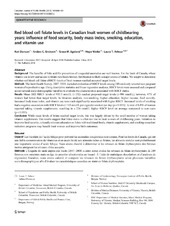| dc.contributor.author | Duncan, Kait | en_US |
| dc.contributor.author | Erickson, Anders C | en_US |
| dc.contributor.author | Egeland, Grace M. | en_US |
| dc.contributor.author | Weiler, Hope A. | en_US |
| dc.contributor.author | Arbour, Laura | en_US |
| dc.date.accessioned | 2019-06-19T09:42:57Z | |
| dc.date.available | 2019-06-19T09:42:57Z | |
| dc.date.issued | 2018-12 | |
| dc.Published | Duncan K, Erickson, AC, Egeland GM, Weiler HA, Arbour L. Red blood cell folate Levels in Canadian Inuit women of childbearing years: invluence of Food insecurity, body mass index, smoking, education, and vitamin use.. Canadian journal of public health. 2018;109(5-6):684–691 | eng |
| dc.identifier.issn | 0008-4263 | |
| dc.identifier.issn | 1920-7476 | |
| dc.identifier.uri | https://hdl.handle.net/1956/20233 | |
| dc.description.abstract | Background: The benefits of folic acid for prevention of congenital anomalies are well known. For the Inuit of Canada, where vitamin use is low and access to folate-rich foods limited, fortification is likely a major source of intake. We sought to determine whether red blood cell folate (RBCF) levels of Inuit women reached accepted target levels. Methods: The Inuit Health Survey, 2007–2008, included evaluation of RBCF levels among 249 randomly selected non-pregnant women of reproductive age. Using descriptive statistics and linear regression analyses, RBCF levels were assessed and compared across several socio-demographic variables to evaluate the characteristics associated with RBCF status. Results: Mean (SD) RBCF levels of 935.5 nmol/L (± 192) reached proposed target levels (> 906 nmol/L); however, 47% of women had lower than target levels. In bivariate analysis, non-smoking, higher education, higher income, food security, increased body mass index, and vitamin use were each significantly associated with higher RBCF. Increased levels of smoking had a negative association with RBCF levels (− 5.8 nmol/L per cigarette smoked per day (p = 0.001)). A total of 6.8% of women reported taking vitamin supplements, resulting in a 226 nmol/L higher RBCF level on average compared to non-users (p < 0.001). Conclusion: While mean levels of folate reached target levels, this was largely driven by the small number of women taking vitamin supplements. Our results suggest that folate status is often too low in Inuit women of childbearing years. Initiatives to improve food security, culturally relevant education on folate-rich traditional foods, vitamin supplements, and smoking cessation/reduction programs may benefit Inuit women and improve birth outcomes. | en_US |
| dc.language.iso | eng | eng |
| dc.publisher | Springer Nature | eng |
| dc.rights | Attribution CC BY | eng |
| dc.rights.uri | http://creativecommons.org/licenses/by/4.0 | eng |
| dc.subject | Inuit | eng |
| dc.subject | Indigenous | eng |
| dc.subject | Folic acid | eng |
| dc.subject | Red blood cell folate | eng |
| dc.subject | Body mass index | eng |
| dc.subject | Food security | eng |
| dc.title | Red blood cell folate levels in Canadian Inuit women of childbearing years: influence of food security, body mass index, smoking, education, and vitamin use | en_US |
| dc.type | Peer reviewed | |
| dc.type | Journal article | |
| dc.date.updated | 2019-01-30T08:26:23Z | |
| dc.description.version | publishedVersion | en_US |
| dc.rights.holder | Copyright 2018 The Author(s) | |
| dc.identifier.doi | https://doi.org/10.17269/s41997-018-0085-y | |
| dc.identifier.cristin | 1668272 | |
| dc.source.journal | Canadian journal of public health | |

